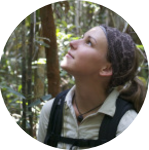About This Project
Orangutans are on the brink of extinction due to habitat loss. Southeast Asia has the highest rate of deforestation in the tropics with less than 10% of forests under any form of protection. Male orangutans produce a long distance vocalization, the long call, which appears to be dependent on food availability, i.e. forest condition. This research aims to discover if vocalization of male orangutans can prove a quicker, less labor-intensive method for detecting forest degradation.Ask the Scientists
Join The DiscussionWhat is the context of this research?
Typically, conservationists use the presence, absence, or densityof “indicator species” - animals that are sensitive to habitat disturbance - to provide an early warning of large scale environmental disturbance. Individual orangutans make ideal indicators for rainforests, because their diet consists of a large quantity and variety of plants and invertebrates.
Additionally, orangutans reproduce very slowly, meaning that it can take a long time for the population to recover once it declines. Consequently, it may be too late to take action to conserve the species once declines are observed.
Using the behavior of an indicator species, rather than its presence or absence, should provide a more sensitive predictor of forest condition. Orangutan are semi-solitary animals. The only form of long distance communication is the long call, which is only produced by male orangutans. The long call is used for multiple social factors including: dominance, indicating direction of travel, mate attraction, caller identity and location. Calling poses a risk by giving away the location of a male to potentially more dominant males who may initiate a fight. Therefore, males in “poor” body condition may call less.
Orangutans experience large changes in body condition across seasons due to variation in food availability. I have observed that males call less in periods of low food availability. I intend to use the existing seasonal variation in forest condition to see if long call rate can reliably mirror current forest condition.
What is the significance of this project?
Rainforests will disappear from the global landscape within thenext hundred years if current deforestation rates continue. Southeast Asia currently has the highest rate of tropical deforestation, and it continues to accelerate each year. Conservation efforts for orangutans would greatly benefit from more effective and sensitive methods for detecting early changes in forest condition.
Recording vocalizations of individuals of an indicator species may provide a more rapid and less labor-intensive method for detecting habitat degradation before population declines are seen. This in turn will indicate forest condition and will provide a more timely detection of forest disturbances, which can lead to a more rapid response by conservation managers. Such responses might include timely adjustments in protection regulations and patrols.
What are the goals of the project?
The goal of this project is to determine the extent to which vocalization of male orangutans can be used as an early warning of forest degradation.
- To determine if long call rate is decreased by a decline in food availability.
- To gather botanical data in the Natural laboratory of Peat-Swamp Forest, in the Sabangau rainforest, Central Kalimantan, Indonesia.
- Compare the long calling rates with various kinds of data on forest quality, including phenological data, results from litter-fall traps and mortality rates of tree and liana species.
- To establish whether monitoring orangutan vocalization could be a useful new early warning indicator for declines in forest quality, allowing earlier appropriate intervention to take conservation measures.
Budget
The funds requested are required to cover four months at the field site in Indonesia. The costs cover the stay at the field site, the salary of one local field assistant, and the cost of batteries for the recording equipment.
Meet the Team
Team Bio
I developed my passion for orangutans and forest conservation when I completed a research internshipwith OuTrop in 2011. After my internship, I returned to the Sabangau Forest to conduct my PhD research. When I am not running around the peat-swamp forest, I enjoy outdoor activities such as hiking, rock climbing, and traveling.OuTrop is a research and conservation organization based in the Sabangau rainforest in the heart of Indonesian Borneo. Since 1999, OuTrop has run a variety of projects to help understand and protect peat-swamp rainforests and the wildlife they are home to. Their primary research focuses on orangutans, southern Bornean gibbons and red langur monkeys. Through ecological monitoring with local partners, OuTrop strives to develop conservation solutions and improve capacity for conservation in the region. OuTrop has already accomplished great strides in conservation with the assistance of a local patrol team to stop illegal logging and has been conducting orangutan research for 12 years.
For a publication list or more information, please visit www.outrop.com
Project Backers
- 21Backers
- 100%Funded
- $2,010Total Donations
- $95.71Average Donation
